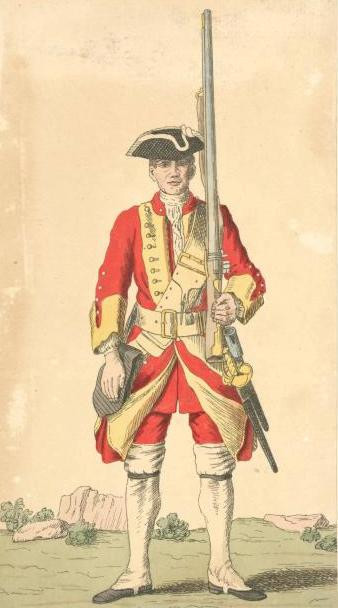While the American Continental Army and colonial militias presented a patchwork of clothing styles that evolved throughout the Revolutionary War, the British Army stood in stark contrast with its commitment to uniformity. For the British, appearance on the battlefield was a matter of paramount importance, dictated by royal decrees and rigorously enforced whenever possible. Famously known as “Redcoats,” British soldiers were generally well-equipped, especially at the war’s outset, a significant advantage over their often under-supplied Continental counterparts.
This guide delves into the details of what British Army soldiers, from the rank and file to their commanding officers, wore during the battles of the American Revolution, exploring the components, the reasons behind their distinctive look, and the practicality of their attire in the American theater of war.
Components of the British Soldier’s Uniform
A British soldier during the American Revolution would have been instantly recognizable by their distinctive uniform, a carefully constructed ensemble designed to project authority and ensure battlefield recognition.
Headwear: Tricorn Hats and Miter Caps
British infantry soldiers were most commonly seen wearing a black felt tricorn hat. This three-cornered hat was typically adorned with a black cockade, a ribbon knot that denoted nationality and regimental affiliation. For Grenadiers, elite infantrymen specializing in hand grenades, the headwear was more imposing: a bearskin miter cap. These tall, slightly conical hats, reminiscent of the modern-day hats worn by the King’s Guard in London but smaller, added to the Grenadiers’ formidable appearance.
Officers and higher ranks enjoyed some variations in their headwear. Lord Rawdon, a notable British lieutenant serving with the 5th Regiment of Foot, was known for his distinctive cap made of cat fur, showcasing a degree of personal style within the regulated framework. It’s a common misconception that British troops wore shakos during the Revolutionary War; however, this style of hat was not adopted by the British Army until 1797, after the American Revolution had concluded.
 British soldier wearing the typical Redcoat uniform.
British soldier wearing the typical Redcoat uniform.
The Shirt and Waistcoat: Essential Base Layers
Beneath the iconic red coat, British soldiers wore practical base layers. A long-sleeved shirt, crafted from cotton or linen, served as the foundational garment. Notably, these shirts featured thick, stiff collars, designed to enforce and maintain a soldierly posture. Over the shirt, a waistcoat, typically red or white, provided an additional layer of warmth and formality.
The Iconic Red Coat: A Symbol of the British Army
The scarlet wool coat was undoubtedly the most recognizable element of the British soldier’s uniform, earning them the enduring nickname “Redcoats.” These coats were meticulously tailored and featured different colored “facings”—the lapels, cuffs, and coat lining—that distinguished regiments.
For instance, the 3rd Regiment of Foot, famously known as “The Buffs,” sported buff-colored facings, a light yellowish hue as illustrated in the image above. Blue, green, and other colors were also prevalent for facings, creating visual distinctions between units. Decorative trim, known as lace, in various colors and patterns, was used to denote a soldier’s rank within the regiment. Officers’ uniforms were further embellished with epaulettes or wings on the shoulders, signifying their elevated status. Worn over the coat was a white leather crossbelt, essential for carrying the soldier’s ammunition pouch or box.
Breeches and Gaiters: Lower Body Attire
For their lower body, British Army soldiers wore breeches, close-fitting pants made of white or cream-colored cloth. These breeches extended to just below the knee. To protect their lower legs and keep dirt and debris out of their shoes, soldiers wore gaiters. These coverings, made of stiff canvas, were typically black or white and reached from the ankle to below the knee. In colder climates or winter conditions, leggings were sometimes added over the calves for extra warmth and protection.
Footwear: Shoes and Boots
Infantry soldiers were equipped with low-cut, black leather shoes, secured with either a buckle or laces. Cavalry soldiers, requiring more leg protection while riding, wore knee-high leather boots, offering substantial coverage and support.
The Significance of the Red Coat: More Than Just a Color
In an age where modern armies favor camouflage in browns and greens, the British Army’s choice of bright red for their uniforms in the 18th century might seem counterintuitive. However, several practical and historical reasons underpinned this distinctive color choice.
Reasons Behind the Red Hue
Several theories explain why the British forces adopted red as their primary uniform color:
- Morale and Practicality: One popular theory suggests red was chosen to bolster soldier morale. The color red was believed to be less likely to show bloodstains, potentially reducing the psychological impact of visible wounds on both the injured soldier and their comrades.
- Cost-Effectiveness of Dyes: Historically, red and crimson dyes were cheaper to produce and more readily available in large quantities compared to many other colors. Furthermore, red dye production was simpler, requiring less complex mixing of different dye colors.
- Battlefield Recognition: In the 16th and 17th centuries, when red uniforms began to be adopted by the British Army, distinguishing friend from foe on the battlefield was as crucial as concealment. Bright red uniforms aided in rapid identification in the chaotic environment of combat, helping to prevent friendly fire incidents. Moreover, battlefields in the era of muskets were often obscured by thick smoke, making long-range visibility challenging regardless of uniform color. The bright red could have actually been advantageous in maintaining unit cohesion and visibility in smoky conditions.
An illustration depicts a private soldier from the First Regiment of Foot Guards, showcasing the detailed elements of the standard British uniform.
Comfort and Practicality: Wearing the Red Uniform
While visually striking and regulation-compliant, the British Army uniform during the American Revolution was often far from comfortable, particularly in the varied and often harsh climates of North America.
The Weight and Layers of the Uniform
Donning a full British uniform was a process that resulted in significant layering. By the time a soldier was fully dressed, they would be wearing at least three layers of clothing, including the heavy woolen coat. Adding to this burden was the weight of military equipment: a musket, ammunition, a knapsack, a water canteen, and, for officers, a sword.
This combination of layers and equipment often led to heat exhaustion, a significant problem for British soldiers, especially when marching or engaged in combat during the warmer months of the American summer.
Reenactors portraying British soldiers during an American Revolution event, illustrating the layered and potentially cumbersome nature of the uniforms.
Discomforts and Limited Relief
Even in cooler weather, the uniform presented various discomforts. The breeches and gaiters were designed to be tight-fitting, restricting movement to some extent. The stiff collars, intended to promote upright posture, were notoriously uncomfortable to wear for extended periods. The use of wool for key garments like the coat and waistcoat, while durable and warm, also made the uniform itchy and irritating against the skin, adding to the soldiers’ discomfort.
Only officers and higher-ranking soldiers enjoyed a degree of relief from these discomforts. They had the financial means to commission custom-tailored uniforms that were often made with slightly looser fits and finer materials, offering marginally better comfort for prolonged wear.
Uniform Adaptations During the War: Evolution, Not Revolution
Despite the strong emphasis on tradition and regulation, the British Army did implement some modifications to their uniforms during the American Revolution, albeit within limits, to improve soldier performance in the specific conditions of the American colonies.
Minor Adjustments for American Conditions
Facing the realities of warfare in America, the British military made some concessions:
- Lighter Fabrics: Particularly in the southern theater of the war, where heat and humidity were more intense, some units began to utilize lighter-weight fabrics when feasible in the production of uniforms, aiming to mitigate heat stress among soldiers.
- Simplification: As the war progressed and supply lines stretched thin across the Atlantic, British Army uniforms gradually became less ornate and more simplified. This was partly driven by logistical constraints but also by a growing recognition of the need to prioritize combat effectiveness, especially after key defeats like the Battle of Saratoga highlighted the challenges of the American conflict.
- Limited Camouflage: While the red coat remained standard, a small number of specialized units began experimenting with adopting colors better suited for camouflage in the American landscape. Green and brown hues were introduced for some units operating in forests and fields, recognizing the tactical advantage of blending into the environment in certain combat scenarios.
Prevailing Tradition and Logistical Challenges
However, these adaptations were limited. Nationalistic sentiment and a belief in the psychological impact of the iconic red uniform on both British soldier morale and enemy intimidation largely prevailed. Maintaining the striking and ornate appearance of the uniforms was often considered more important than maximizing soldier agility and comfort in the field.
Furthermore, the immense logistical undertaking of supplying units across the Atlantic Ocean as the war dragged on presented a significant barrier to wholesale uniform changes. Even if the British high command had been willing to abandon tradition and drastically alter soldier uniforms—a highly unlikely prospect—implementing such a change on a large scale would have been logistically daunting and potentially disruptive to the war effort.
In conclusion, British uniforms during the American Revolution were a complex blend of tradition, practicality, and evolving necessity. The iconic red coat, while symbolically powerful and rooted in historical and practical reasons, was also a source of discomfort in the American climate. While some adaptations were made to address the demands of the American theater, the British Army largely adhered to its established uniform regulations, prioritizing visual impact and unit recognition, even as the realities of warfare in the New World presented new challenges.

